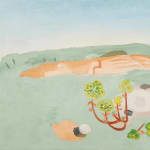Winifred Nicholson 1893-1981
Wild Flowers of the Garrigue, 1935, circa
oil on canvas
45.7 x 61 cm
18 x 24 in
18 x 24 in
Winifred Nicholson’s 'Wild Flowers of the Garrigue' belongs to a period when the artist was travelling and painting extensively in southern Europe, particularly in the Mediterranean. The “garrigue” refers to...
Winifred Nicholson’s 'Wild Flowers of the Garrigue' belongs to a period when the artist was travelling and painting extensively in southern Europe, particularly in the Mediterranean. The “garrigue” refers to the dry, scrubby landscape of southern France, where aromatic herbs, wild flowers, and stony outcrops define the terrain. In this painting, Nicholson distils that setting into a spare and compact composition: a few flowering plants spring from rocky ground in the foreground, while pale ochre cliffs and a soft blue sky stretch beyond. The effect is one of clarity and restraint, in which the essential character of place is conveyed with minimal means.
During the early 1930s, Nicholson moved in circles that included some of the most influential artists of her generation. She and her then-husband Ben Nicholson were closely connected to Christopher Wood, Alfred Wallis, and later to Piet Mondrian and Jean Hélion. While her own work retained its distinctive focus on flowers and domestic subjects, the simplicity of form and clarity of colour seen in 'Wild Flowers of the Garrigue' resonates with these wider modernist conversations. The flattened perspective and reduced forms are reminiscent of Wood’s Mediterranean paintings, while the controlled palette and compositional balance echo the purity admired in Mondrian’s abstractions.
The painting’s modest scale is also significant. Many of Nicholson’s most sought-after works are similarly compact, reflecting her belief that intimacy and immediacy were best achieved on a smaller surface. Here, the spareness of the scene heightens its poetic quality: a few blooms and a snail shell become emblems of resilience and beauty within a pared-down landscape.
Although understated, 'Wild Flowers of the Garrigue' exemplifies the qualities that make Nicholson’s finest works so valued—economy of means, freshness of vision, and a rare ability to transform simple natural motifs into expressions of both place and spirit.
During the early 1930s, Nicholson moved in circles that included some of the most influential artists of her generation. She and her then-husband Ben Nicholson were closely connected to Christopher Wood, Alfred Wallis, and later to Piet Mondrian and Jean Hélion. While her own work retained its distinctive focus on flowers and domestic subjects, the simplicity of form and clarity of colour seen in 'Wild Flowers of the Garrigue' resonates with these wider modernist conversations. The flattened perspective and reduced forms are reminiscent of Wood’s Mediterranean paintings, while the controlled palette and compositional balance echo the purity admired in Mondrian’s abstractions.
The painting’s modest scale is also significant. Many of Nicholson’s most sought-after works are similarly compact, reflecting her belief that intimacy and immediacy were best achieved on a smaller surface. Here, the spareness of the scene heightens its poetic quality: a few blooms and a snail shell become emblems of resilience and beauty within a pared-down landscape.
Although understated, 'Wild Flowers of the Garrigue' exemplifies the qualities that make Nicholson’s finest works so valued—economy of means, freshness of vision, and a rare ability to transform simple natural motifs into expressions of both place and spirit.
Provenance
Estate of the ArtistExhibitions
London, Leicester GalleriesLondon, Levefre Gallery (4182)



